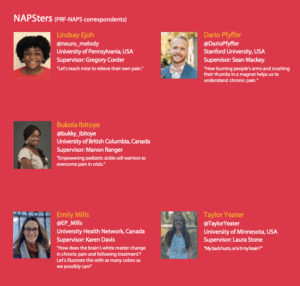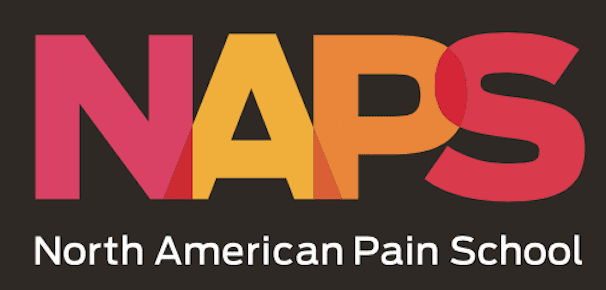Five early-career pain researchers are participating in the PRF-NAPS Correspondents program covering the 2023 North American Pain School, which took place from 18-23 June in Montebello, Québec City, Canada. The Correspondents program is a unique science communication training program that provides participants with knowledge and skills needed to communicate science effectively to a wide range of pain researchers, patients, and the greater public. The Correspondents will conduct interviews with NAPS Visiting Faculty and Patient Partners, write summaries of scientific lectures – and provide blogging too! Take a look at their final blog posts reflecting on NAPS below.
See previous blog posts about this meeting
2023 NAPS Blog Posts: Reflections
I struggle with rejection in academia. As a fourth-year PhD candidate who’s applied to numerous fellowships and academic programs, I’ve encountered a lot of rejection. These experiences used to make me wonder if I belonged in academia – truthfully, I’m still hurt when I’ve worked very hard on something and don’t observe the desired outcome – but I’m evolving.
The semester before attending NAPS, I wrote and submitted a D-SPAN (Diversity Specialized Predoctoral to Postdoctoral Advancement in Neuroscience) F99/K00 fellowship application through the National Institutes of Health, proposing to investigate thalamocortical circuits during pain and analgesia. Days before NAPS, I received a notice that my grant was scored but not highly. I was discouraged. I felt like my hard work was wasted, and I wondered where I went wrong in the process. I left for NAPS excited to network and learn more about pain research, and grateful for the distraction from my less-than-fabulous grant score.
The atmosphere at NAPS was warm and welcoming, and I was able to gain some invaluable perspective from others with similar experiences. I learned that receiving any score on an NIH grant is something to be celebrated and proud of. I should never feel bad about myself or question my place here because of rejection. It is an integral aspect of academic science, and one we shouldn’t take personally. I was encouraged to resubmit the grant application and continue chasing my dreams.
I’m heartened to know that I have amazing, like-minded people in my field who are rooting for my success. NAPS 2023 taught me that the future of the pain field is bright – and not simply because of the brilliant scientists, but also the kind and encouraging people.
Lindsay Ejoh is a PhD candidate at the University of Pennsylvania, USA. You can follow her on Twitter – @neuro_melody.
If you follow NAPS on Twitter, it shouldn’t be news to you that NAPS was great! Just to recap for the non-Twitter squad, NAPS was awesome, and NAPSters have captured their experience using words like unforgettable, amazing, enlightening, and memorable. In case you were wondering, I believe it was remarkable. What really made NAPS worthy of all these adjectives?
There are a plethora of factors – and every NAPSter most likely has a different response – but I’ll focus on two things that stood out to me.
First, I felt as though the barrier between established pain scientists and trainees was dismantled. I’m much more familiar with separation – where the “gurus” receive special treatment away from the apprentices. Yet here I was, sitting across the table and sharing meals with Christine Chambers, Jeff Mogil, and Frank Porreca – John Farrar even helped to buckle up my life jacket before our rafting trip. It’s surreal!
The humility of these awesome mentors sharing their experiences – and willingness to create a safe place for growth – was truly remarkable. At one point, Yenisel Cruz-Almeida whispered to me, “Don’t be shy. It’s a safe place.” They’ve set a great example for the future generation of pain scientists.
Second, I was awed by the versatility of my fellow trainees. It was admirable to see people transition from talking about the complexities of basic science to giving Oscar-worthy performances during role plays at various workshops (a special shout out to Lakeisha Lewter and John Del Rosario!). The trainees were kind and ready to establish new friendships.
While the venue and food were awesome, what really made NAPS special was the people. I’d like to thank the trainees, Visiting Faculty, Patient Partners, Erwin Leclair, Iulia Tufa, Greg Carbonetti, and our amazing tour guide Phil, who captained my boat safely through the wild waves of the Rouge River.
Bukola Ibitoye is a PhD candidate at the University of British Columbia, Canada. You can follow her on Twitter – @bukky_ibitoye.
How can we measure the impact of a week at NAPS? At the end of this year’s program, trainees, Visiting Faculty, and Patient Partners alike described how valuable the experience had been for them. NAPS’ true impact, however, can only be measured in the long-term. In the future, how often will we say, “I understand this concept thanks to NAPS,” or, “I developed this skill at NAPS,” or, “I met this friend and collaborator at NAPS”?
And yet, how is it possible that NAPS can have such an immediate, profound impact?
When I spoke with my family afterwards, I described NAPS as a “pain melting pot.” Jeff Mogil, Christine Chambers, Erwan Leclair, Iulia Tufa, the Executive Committee worked tirelessly to throw a mix of trainees and Visiting Faculty from different backgrounds into an intense and nurturing (albeit slightly sleep-deprived) educational environment. We all listened and learned from each other in an intimate setting that no other conference can provide. My Mum in Australia thought it sounded crazy, and perhaps it was – but it was the best kind of crazy.
The Visiting Faculty and NAPSters inspired me daily, my fellow PRF-NAPS Correspondents kept me motivated late at night, and Greg provided unconditional support.
Our Patient Partners – Keith Meldrum and Jennifer Daly-Cyr – helped to constantly remind us why we “do what we do,” and provided inspiration for the future of pain research.
It’s been about a week since NAPS ended, but the experience has already impacted me far greater than I could have imagined. I’ve thought deeply about the topics discussed during conversations, considered how to implement advice given in workshops, and further researched the ideas raised in scientific talks. I’ve had phone calls with other graduates, and already continued my conversation with Jennifer, sparking new ideas for research projects.
I’ll sign off by urging all pain research trainees to apply for next year’s program. Take this as a testimonial from a recent NAPS graduate: Time will tell the true impact that NAPS has had on me, but for now, I know I have made friends for life, developed ideas for new projects, and found renewed hope for the future of pain research. I think that’s quite remarkable for a one-week program. Wouldn’t you agree?
Emily Mills is a postdoctoral researcher at the Krembil Brain Institute, University Health Network, Toronto, Canada. You can follow her on Twitter – @EP_Mills.
NAPS 2023 is over. It’s finished, and I won’t have an opportunity to attend as a trainee again. It’s been about a week since I returned home, and I’ve been lying in my bed lethargically, missing the “energy.”
Exaggeration aside, I’m sad it’s over. I spent one of the best weeks of my life in Montebello, alongside some of the most talented, experienced, and renowned pain researchers and clinicians in the world. I appreciate that I was given the chance to participate. It was an honor to hear from people with lived experience about their pain journey, and our common mission of alleviating pain brought us together and enabled this unique experience that would not have been possible otherwise.
Five days packed with presentations about groundbreaking studies, incredibly helpful and inspiring workshops, and networking opportunities with the Executive Committee, Visiting Faculty, Patient Partners, and fellow NAPSters. Last but certainly not least, as a PRF-NAPS Correspondent, I appreciated the opportunity to receive training in science communication. Keep your eyes open @PainResForum: I’m not done with you! You’ll get the chance to read my session recap on a talk about “Acute to Chronic Pain Transitioning” presented by John Farrar (University of Pennsylvania, USA) and an interview with Rachael Bosma (University of Toronto, Canada) in the coming weeks!
I truly enjoyed every second of the intensive NAPS program. While I didn’t know what to anticipate pre-NAPS, all of my hopes, wishes, and expectations were exceeded. Not only did I receive a one-of-a-kind pain education, but I also got the chance to expand my network and make friends for life.
Dario Pfyffer is a postdoctoral research scholar at Stanford University, California, USA. You can follow him on Twitter – @DarioPfyffer
Post-PhD burnout is real. We all talk about it and know it’s real, but somehow it can still feel like you’re alone – especially when you’re deciding to stay on the academic route and run your own lab one day. My truth is that almost none of my friends want to stay in academia, and it can feel lonely.
The one-year anniversary of my dissertation defense arrived just after NAPS. Of course, this led me to reflect on how I’ve felt since earning my PhD. Honestly, I still feel burnt out. After five years in graduate school, I find it draining to collect and analyze data. At NAPS, I met people who knew this feeling, too, and left academia, and I asked about their path. I also met people who were undeterred by this feeling and were committed to academia, and asked how they handled it. I also met people who are still figuring it out, and we chatted about how unsettling it is to be unsure.
The beautiful thing about NAPS is that all of these people were in the same room as I for five days. The schedule was packed with science, communication, entrepreneurship, negotiation, and inspiring conversations with Patient Partners. I was reminded of the freedom and opportunity that comes with an academic career path.
I also recalled that I love being creative, curious, and inspired – to think, “Oh! What a cool question! How can we answer it?” Or “Wow! I had no idea you could do a Von Frey test and not even be in the room; I can’t wait to ask Justin more about this!”
I remembered that I love mentorship and communication in science, and have been inspired by my PRF-NAPS Correspondent friends who run their own science communication accounts (check out Lindsay’s social media and Emily’s podcast).
At NAPS, I was reminded to be myself. Carve my own path. Define what success means to me. This still means a lot of hard work ahead, but no matter what my path looks like, I know the pain research community has my back.
Taylor Yeater is a postdoctoral fellow at the University of Minnesota, USA. You can follow her on Twitter – @TaylorYeater
The 2023 PRF-NAPS Correspondents



